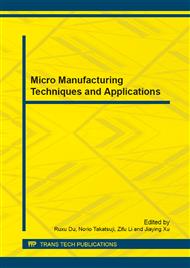p.39
p.45
p.53
p.63
p.69
p.75
p.81
p.87
p.93
Simulation of Acoustic Field for Megasonic Bath Cleaning in Advanced Semiconductor Manufacturing
Abstract:
Megasonic cleaning has been one of the most successful techniques for nanoparticle cleaning in semiconductor industry. However, the megasonic energy often causes a pattern collapse and some damage to very small structure. In this study, the distribution of sonic pressure in a wet cleaning bath with different arrangement of megasonic transducers is simulated. Megasonic wave transmits directional and will be disturbed. Thus the wafer surfaces should be arranged parallel to the sound wave direction of propagation. Convergence gain in the whole cleaning space is limited but results in great variance in local areas. Thus the wafer moving, rotating and oscillating is necessary.
Info:
Periodical:
Pages:
81-86
Citation:
Online since:
February 2013
Authors:
Keywords:
Price:
Сopyright:
© 2013 Trans Tech Publications Ltd. All Rights Reserved
Share:
Citation:


